Sportforum Hohenschönhausen
Sportforum Hohenschönhausen is a multi-purpose sports complex in the locality of Alt-Hohenschönhausen of the borough of Lichtenberg in Berlin. The Sportforum was named Dynamo-Sportforum during the East German era.
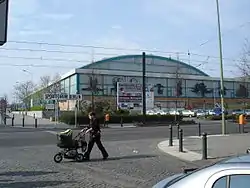
Sportforum Hohenschönhausen covers an area between 45 and 50 hectares, and comprises 35 sports facilities, including three ice rinks, two athletics halls, a football stadium, as well as eight other halls and open spaces for various sports.[1][2] Development of the Dynamo-Sportforum began in 1954. The original building ensemble, including the Dynamo-Sporthalle, which was built in individual sections from 1955, based on designs by an architectural collective led by Walter Schmidt, is a protected building of cultural heritage. Expansion of the Sportforum continued into the 1980s. The complex is the second largest sports complex in Berlin after the Olympiapark.[1][3][4][5][6][7][8]
The Dynamo-Sportforum was the training center where the top athletes and future Olympic medalists trained during the East German era.[9][5] It was the headquarter of sports association SV Dynamo and home to sports club SC Dynamo Berlin.[10] The Olympic Training Center Berlin (OSP Berlin) is now the main user of the facilities. Around 20 sports clubs are also based in the Sportforum and more than 3,000 athletes use the facilities every day.[9]
Location
The Sportforum Hohenschönhausen is located in the western part of the locality of Alt-Hohenschönhausen of the borough of Lichtenberg in Berlin. It is bordered on the north by an industrial area (on which, among other establishmens, the Berliner-Kindl-Schultheiss-Brauerei is located), on the east by the St. Andrew and St. Mark's Cemetery (German: Friedhof der St. Andreas - und St. Markusgemeinde), on the south by the Konrad-Wolf-Straße and on the west by the Weißenseer Weg.
Facilities

The Sportforum Hohenschönhausen covers an area between 45 and 50 hectares, and comprises 35 sports facilities, including three ice rinks, two athletics halls, a football stadium, as well as eight other halls and open spaces for athletics, swimming, handball, volleyball, judo, fencing, archery, beach volleyball and football.[1][2] The Sportforum is the second largest sports complex in Berlin after the Olympiapark.[1]
Development of the Dynamo-Sportforum began in 1954.[3][4] The building ensemble was built in individual sections from 1955, based on designs by an architectural collective led by Walter Schmidt, which had emerged as the winner of an architectural competition held in 1953.[3][4][5][6] The Sportforum was expanded according to requirements by adding additional facilities and expansion continued into the 1980s.[3][4][5]
The original building ensemble built from 1955 to 1959 is now a protected building of cultural importance.[6][7][8] The facilities includes artworks such as mosaic artwork by Wolfgang Frankenstein in the foyer of the Dynamo-Sporthalle and the swimming hall, the copper artwork "Sport-Fries" by Wolfgang Frankenstein on the facade of the athletics hall at Konrad-Wolf-Straße and the two bronze sculptures "Seated Swimmer" (German: Sitzende Schwimmerin) by Gustav Weidanz and "Standing Swimmer" (German: Stehende Schwimmerinnen) by Waldemar Grzimek at the outdoor swimming pool.
Use of the site
The Dynamo-Sportforum was built as a training center for elite sport. It was used by the top athleltes and future Olympic medalists of East Germany.[9][5] The central management of SV Dynamo had its offices in the Dynamo-Sportforum.[10]
The sports club SC Dynamo Berlin, with its many sports, disciplines and squads, was the main user of the first buildings. The Olympic Training Center Berlin (OSP Berlin) has used the Sportform since the beginning of the 1990s and is now the main user of the facilities.[9][5] More than 300 national team athletes regularly train in the faciliy. The Olympic Training Center Berlin (OSP Berlin) is the largest Olympic training center in Germany.[1]
The Sportforum is also home to eleven state training centres with around 800 state team athletes, the location for the Berlin School and Sports Center Berlin (SLZB) (formerly known as the elite Children and Youth Sports School (KJS) ”Werner Seelenbinder”), the "House of Athletes" with around 200 boarding school places, and the Institute for Sports Science of the Humboldt University of Berlin, with approximately 500 students. Around 20 sports clubs as based in the Sportforum and more than 3,000 athletes use the facilities every day.[1][9]
The main users among the sports clubs based in the Sportforum are BFC Dynamo, Eisbären Berlin junior teams, SC Berlin, Berliner TSC and Alba Berlin junior teams. Other users are Füchse Berlin, SSG Humboldt zu Berlin, SC Charlottenburg and SV Preußen Berlin.[1][9]
Ice sports arenas
The Wellblechpalast opened on the sports complex in 1963. It was the home arena of the ice hockey department of SC Dynamo Berlin, and served as the home arena of its continuation, the Eisbären Berlin, until 2008. The arena has a seating capacity for 4,695 people.
A 400 m speed skating indoor arena opened on 17 November 1986, and was the first covered speed skating oval in the world, one day prior to Thialf in Heerenveen which hosted the World Allround Speed Skating Championships for Men later that season.
Speed skating track records
- 500 m (m): 34.85; Jeremy Wotherspoon, 14 March 2003
- 500 m (w): 37.52; Jenny Wolf, 6 November 2009
- 1000 m (m): 1:08.53; Shani Davis, 6 November 2009
- 1000 m (w): 1:15.04; Christine Nesbitt, 11 March 2012
- 1500 m (m): 1:44.47; Shani Davis, 8 November 2009
- 1500 m (w): 1:54:88; Jorien ter Mors, 8 December 2013
- 3000 m (m): 3:46.17; Håvard Bøkko, 25 October 2008
- 3000 m (w): 4:00.75; Martina Sáblíková, 6 November 2009
- 5000 m (m): 6:09.76; Sven Kramer, 17 November 2006
- 5000 m (w): 6:59.26; Martina Sáblíková, 10 February 2008
- 10000 m (m): 13:09.06; Sven Kramer, 10 February 2008
- Team pursuit (m): 3:40.79; Netherlands, 19 November 2006
- Team pursuit (w): 3:01.03; Canada, 11 March 2012
Football stadium
 Stadion im Sportforum in 2006. | |
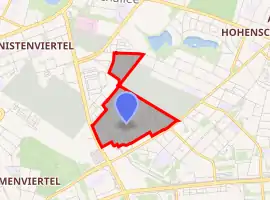
| |
| Former names | Dynamo-Stadion im Sportforum |
|---|---|
| Address | Weißenseer Weg 51-55, 13053 Berlin |
| Public transit | Sportforum (M13), Sandinostraße (M5) |
| Owner | State of Berlin |
| Capacity | 12,400[11] |
| Record attendance | 20,000 (BFC Dynamo-Liverpool F.C., 29 November 1972)[12] |
| Construction | |
| Opened | 1970 |
| Renovated | 2005-2006 |
| Construction cost | 1 million Mark |
| Tenants | |
| BFC Dynamo | |
A sports field on the site of the football stadium was established already in the 1920s.[10] The stadium was completed in its current form in 1970 and initially held a capacity of 20,000 spectators.[2][13][nb 1] The site had previously been occupied by the Sportplatz Steffenstraße, which had already been used by BFC Dynamo and its predecessor, the football department of SC Dynamo Berlin. SC Dynamo Berlin played its first seasons at the Walter-Ulbricht-Stadion in Mitte, but moved to the Dynamo-Sportforum after the construction of the Berlin wall in 1961.[16]
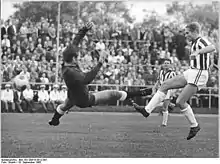
BFC Dynamo played only for a short period in the new stadium, before the team moved permanently to the larger and more centrally located Friedrich-Ludwig-Jahn-Sportpark in Prenzlauer Berg in 1972. The Friedrich-Ludwig-Jahn-Stadion had become vacant when FC Vortwärts Berlin was relocated to Frankfurt an der Oder on 31 July 1971. The Dynamo-Stadion im Sportforum was rarely used for larger matches from then. The stadium would be used mostly by the reserve team of BFC Dynamo, the BFC Dynamo II.
Neverless, BFC Dynamo also played its 1972-73 UEFA Cup matches against SCO Angers, Levski Sofia and Liverpool F.C. at the stadium. The attendance of 20,000 spectators during the match against Liverpool F.C. on 29 November 1972 is still the record attendance for the stadium as of 2020.[13] And the team also returned Dynamo-Stadion im Sportforum in 1986, as the Friedrich-Ludwig-Jahn-Sportpark was under renovation during the 1986–87 DDR-Oberliga season. BFC Dynamo also played its 1986-87 European Cup matches against Örgryte IS and Brøndby IF at the stadium. The match against Örgryte IS on 1 October 1986 was attended by 15,000 spectators.[17]
BFC Dynamo, under the interim name FC Berlin since February 1990, played its home matches in the 1990–91 2. Bundesliga play-off at the Stadion im Sportforum. The club then moved permently to Sportforum Hohenschönhausen in September 1992. The stadium now has a capacity of 10,000 standing places and 2,400 seated places, of which 400 are roofed.[11][13] BFC Dynamo made plans to buy the stadium in 1998.[18] The plans eventually failed due to lack of financial resources. The club also made plans to completely rebuild the stadium in 2006.[19] These plans did not materialize either.
The Stadion im Sportforum was refurbished during the 2005-06 season, to include new fences and player tunnels required to meet security standards.[20] BFC Dynamo moved permanently to the Friedrich-Ludwig-Jahn-Sportpark in the 2014–15 season, following its advance to the Regionalliga Nordost and the subsequent higher media and spectator interest.[21] However, the club returned to play matches at the Stadion im Sportforum in 2019 due to security issues relating to the deteriorating state of the floodlights at the Friedrich-Ludwig-Jahn-Sportpark, which resulted in a temporary closure of the stadium, and are set to return to the Stadion im Sportforum during the 2020–21 season, as the Friedrich-Ludwig-Jahn-Sportpark is planned to be demolished in 2020 and then completely redeveloped.[22][23]
The German Football Association (DFB) has classified the Stadion im Sportforum with a possible third division standard, if only a few small requirements are met, such as new press seats and a better separated press block.[13] The Senate of Berlin is planning renovations for a cost of € 3 million as of 2020.[24]
Dynamo-Sporthalle
The Dynamo-Sporthalle is an indoor sports hall with a capacity of 2,000 to 4,000 spectators located on the Weißenseer Weg. The sports hall was built from 1955 and 1958.[4][8] It was inaugurated in presence of Walter Ulbricht, the president of SV Dynamo Erich Mielke and sprinter Christa Stubnick, among others, on 25 January 1958. It measures 47 meters in width, 65 meters in length and 15 meters in height inside, and thus allows several sports such as athletics, handball, boxing, judo, basketball and gymnastics.
The Dynamo-Sporthalle was also used for congresses and political mass meetings during the East German era, such as the first Women's congress of the Democratic Women's League of Germany (DFD) on 25 June 1964.[25] The Dynamo-Sporthalle was also the location for the special party congresses of the Socialist Unity Party (SED) on 8-9 and 16-17 December 1989, when the party decided to rename itself SED-PDS.[26]
The Dynamo-Sporthalle is still in operation and is used for various smaller events.
Sporthotel and Congress center
The Sporthotel and Congress center was built to serve the athletes training at the Sportforum and to complement the Sportforum. The facility contained a hotel with 200 beds, a congress center and a restaurant.[27][28] The Sporthotel and Congress center is located at the south-western end of the Sportforum (in the corner between Weißenseer Weg and Konrad-Wolf-Straße).[28]
The Dynamo-Sporthotel was built from 1960 to 1962 as a hotel in three storeys with an attached restaurant.[29] The facility was siginificiantly expanded in the late 1970s with a congress center in two to three storeys.[30][28]
The Sporthotel and Congress center was built as a showcase complex for East German sports.[30][28] It was used by athletes such as Franziska van Almsick of SC Dynamo Berlin and Claudia Pechstein, but became vacant in the 1990s and fell into disrepair.[27][30][28] The site is currently awaiting redevelopment and the remains of the Sporthotel and Congress center will be demolished. A new hotel is planned to be built on the site, as of 2020.[31]
Gallery
 Inside the Dynamo-Sporthalle during an Athletics Festival in 1958.
Inside the Dynamo-Sporthalle during an Athletics Festival in 1958. Athlete Ingrid Föst of SC Dynamo Berlin during the Werner-Seelenbinder-Gedenkturnier in the Dynamo-Sporthalle in 1963.
Athlete Ingrid Föst of SC Dynamo Berlin during the Werner-Seelenbinder-Gedenkturnier in the Dynamo-Sporthalle in 1963. The foyer of the Dynamo-Sporthotel in 1964.
The foyer of the Dynamo-Sporthotel in 1964. Inside the swimming hall during the East German Swimming Championship in 1976.
Inside the swimming hall during the East German Swimming Championship in 1976. Michael Schulz of BFC Dynamo and defending Mario Roth of FC Vorwärts Frankfurt, during a match at the Dynamo-Stadion im Sportforum in 1986.
Michael Schulz of BFC Dynamo and defending Mario Roth of FC Vorwärts Frankfurt, during a match at the Dynamo-Stadion im Sportforum in 1986.
 The Dynamo-Sporthalle in 2006.
The Dynamo-Sporthalle in 2006.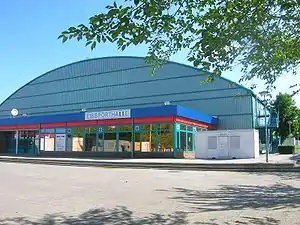 The Wellblechpalast in 2006.
The Wellblechpalast in 2006. The ruins of the congress center in 2006.
The ruins of the congress center in 2006.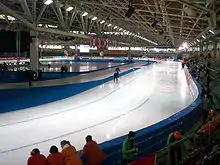 The speed skating oval during 2008–09 ISU Speed Skating World Cup in Berlin in 2008.
The speed skating oval during 2008–09 ISU Speed Skating World Cup in Berlin in 2008. A match between BFC Dynamo and Türkspor Futbol Kulübü at the Stadion im Sportforum in the 2017-18 Berlin Cup.
A match between BFC Dynamo and Türkspor Futbol Kulübü at the Stadion im Sportforum in the 2017-18 Berlin Cup.
See also
Notes
References
- "Sportforum Berlin". www.berlin.de (in German). Berlin: State of Berlin. n.d. Retrieved 6 August 2020.
- "Lichtenberg entdecken - 1 Hohenschönhausen - Rad- und Fußtouren durch den Bezirk" (PDF). museum-lichtenberg.de (in German). Berlin: Museum Lichtenberg im Stadthaus. n.d. p. 11. Retrieved 7 August 2020.
- "Wettbewerb zum Sportforum Berlin: Ergebnisse der Onlinebeteiligung veröffentlicht". www.berlin.de (in German). Berlin: State of Berlin. n.d. Retrieved 7 August 2020.
- "„Diktat und Erfolg" Ausstellung über das Sportforum Hohenschönhausen 1954–1990". museum-lichtenberg.de (in German). Berlin: Museum Lichtenberg im Stadthaus. 5 December 2008. Retrieved 30 July 2020.
- "Olympiastützpunkt Berlin". upl-lichtenberg.de (in German). Berlin: Bezirksamt Lichtenberg von Berlin. n.d. Retrieved 7 August 2020.
- "Die Wiege der Weltmeister". B.Z. (in German). Berlin: B.Z. Ullstein GmbH. 25 November 2008. Retrieved 7 August 2020.
- "Landesdenkmalamt Berlin: Sportforum Berlin". stadtentwicklung.berlin.de (in German). Berlin: Landesdenkmalamt Berlin. n.d. Retrieved 7 August 2020.
- "Denkmalliste Berlin - 09045511" (PDF). berlin.de (in German). Berlin: State of Berlin. 10 December 2019. p. 236. Retrieved 7 August 2020.
- "Sportforum Hohenschönhausen". visitberlin.de. Berlin: Berlin Tourismus & Kongress GmbH. n.d. Retrieved 6 August 2020.
- "Wettbewerb: Sportforum Berlin - Berlin Lichtenberg - Auslobung" (PDF). espazium.ch (in German). Berlin: Senatsverwaltung für Stadtentwicklung und Wohnen. 5 June 2020. Retrieved 18 September 2020.
- "Dynamo Stadion im Sportforum Hohenschönhausen". sport.de (in German). Münster: HEIM:SPIEL Medien GmbH & Co. KG. n.d. Retrieved 19 September 2020.
- "Europa League - Spielinfo - Europa League 1972/73, Achtelfinale - BFC Dynamo - Liverpool 0:0". Kicker Online (in German). Nuremberg: Olympia Verlag GmbH. n.d. Retrieved 6 August 2019.
- Schlehahn, Britt (17 May 2020). "Vor dem Abriss nochmal BFC Dynamo gegen BSG Chemie - Corona verhindert letztes Halali". Sportbuzzer (in German). Hannover: Sportbuzzer GmbH. Retrieved 31 July 2020.
- "Vorlage zur Beschlussfassung über Gesetz über die Feststellung des Haushaltsplans von Berlin für das Haushaltsjahr 2004/2005 (Haushaltsgesetz 2004/2005 - HG 2004/2005) Kapitel 1064 über Sportforum — Vorlage des Abschlussberichtes Anlage Nutzungs- und Entwicklungskonzept Sportforum Berlin nebst Anlagen 64. Sitzung des Hauptausschusses vom 4.2.2004 - rote Nr. 1909" (PDF). parlament-berlin.de (in German). Berlin: Senatsverwaltung für Bildung, Berlin, Jugend und Sport. 4 June 2004. p. 7 (14) (Anlage 4 - Baulicher Zustand der bestehenden Sportanlagen). Retrieved 18 September 2020.
- "Wettbewerb: Sportforum Berlin - Berlin Lichtenberg - Auslobung" (PDF). espazium.ch (in German). Berlin: Senatsverwaltung für Stadtentwicklung und Wohnen. 5 June 2020. p. 33 (Abb. 7). Retrieved 19 September 2020.
- Grüne, Hardy (1 June 2020). "Der angefeindete Serienmeister des Ostens". Fußball-Woche (de) (in German). Hamburg: SPM Sportplatz Media GmbH. Retrieved 16 August 2020.
- "Spielinfo - BFC Dynamo - Örgyte 4:1 - 1. Runde - Europapokal der Landesmeister 1986/87". kicker Online (in German). Nuremberg: Olympia Verlag GmbH. n.d. Retrieved 13 September 2020.
- Rößling, Ingo (19 April 1998). "FC Berlin will Stadion im Sportforum kaufen". Berliner Morgenpost (in German). Berlin: Berliner Morgenpost GmbH.
- Schulz, Jürgen (4 April 2006). "BFC Dynamo plant neues Stadion!". B.Z. (in German). Berlin: B.Z. Ullstein GmbH. Retrieved 6 August 2020.
- Görke, André; Goldmann, Sven (7 March 2008). "Tribünen in Trümmern". Der Tagesspiegel (in German). Berlin: Verlag Der Tagesspiegel GmbH. Retrieved 6 August 2020.
- Bardow, Dominik (11 August 2014). "Wende im Gelände". Der Tagesspiegel (in German). Berlin: Verlag Der Tagesspiegel GmbH. Retrieved 20 September 2020.
- Brandbeck, Leonard (4 May 2019). "Absturzgefahr - Das Licht bleibt aus". Der Tagesspiegel (in German). Berlin: Verlag Der Tagesspiegel GmbH. Retrieved 6 August 2019.
- Mohren, Johannes (18 July 2019). "Mit neuem Stil die Fans begeistern". www.rbb24.de (in German). Berlin: Rundfunk Berlin-Brandenburg. Archived from the original on 29 July 2020. Retrieved 6 August 2019.
- Koch-Klaucke, Norbert (16 July 2020). "Jahn-Stadion: Kein Platz für Vereine". Berliner Kurier (in German). Berlin: Berliner Verlag GmbH. Retrieved 6 August 2020.
- Conradt, Sylvia (25 June 2014). "Vor 50 Jahren: Der erste Frauenkongress in der DDR". deutschlandfunkkultur.de (in German). Cologne: Deutschlandradio. Retrieved 5 August 2020.
- Meisner, Matthias (8 September 2013). "Von der SED zur Linkspartei: Auferstanden aus Ruinen". Zeit Online (in German). Hamburg: Zeit Online GmbH. Retrieved 5 August 2020.
- Winternitz, André (25 September 2014). "Kongresszentrum Sportforum Berlin". rottenplaces.de (in German). Schloß Holte-Stukenbrock: André Winternitz. Retrieved 5 August 2020.
- Bürkner, Birgit (5 December 2019). "Diese vier Geisterstätten im Osten Berlins warten auf einen Neuanfang". B.Z. (in German). Berlin: B.Z. Ullstein GmbH. Retrieved 5 August 2020.
- "Sporthotel im Sportforum Hohenschönhausen". fotowiesel.de (in German). n.d. Retrieved 5 August 2020.
- "Sporthotel Hohenschönhausen". rbb888.de (in German). Berlin: Rundfunk Berlin-Brandenburg. 25 May 2018. Retrieved 5 August 2020.
- Müller, Berit (16 March 2020). "Öffentlichkeitsbeteiligung Läuft: Neue Pläne für zwei Ruinengrundstücke". Berliner Woche (in German). Berlin: Berliner Wochenblatt Verlag GmbH. Retrieved 5 August 2020.
External links
| Wikimedia Commons has media related to Sportforum Hohenschönhausen. |
- Sportforum Berlin - City of Berlin (in German)